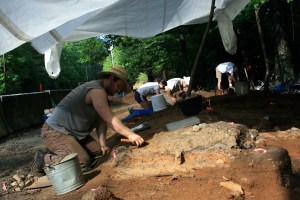STRONG — Ancient tribal history in Franklin County is being carefully documented and preserved before a Route 4 road reconstruction project covers the remnants of the encampment forever.
Maine Historic Preservation Commission archaeologists John Mosher and Bill Burgess and their skilled crew of technicians have spent the summer digging, sifting and documenting their finds, while heavy logging trucks roar by just a few feet from their work site.
The crew has dug a series of small shovel test pits in even grids, and they continue to sift dirt daily to find any artifacts that can be studied and housed at the Maine State Museum. The sequential phases of digging can lead to more significant areas with important finds, but they also can lead to nothing of significance.
Mosher, the field supervisor of this exploration project, said the Maine Department of Transportation plans to smooth a sharp curve, starting at the intersection of the Sandy River bridge and continuing north towards Avon. Since that section of the road is on the river, MDOT site planners were required to hire commission experts to determine whether there were cultural artifacts and to document their findings. The area was home to hunter-gatherers who were primarily nomadic, and little is known about them, Mosher said.
“We cannot tie them to modern-day tribes,” he said. “We don’t even know if they stayed in Maine.”
The area is at least 7,000 years old, he said, so any artifacts could provide important historical clues. The junction of rivers and streams traditionally were campsites and fishing destinations, and these nomadic tribes camped seasonally to make new arrowheads, process their fish and repair equipment.
Although the finds have not been unique or unusual, the site has been interesting to explore, Mosher said. Some of the earth layers indicate remnants of a fire pit, while other sections show where tools might have been made, including knives, spear tips and arrowheads.
“We found flaking debris from a spear point manufacturing site,” Burgess said. “They probably brought cobbles up from the beach and split them to make those flakes.”
That ancient skill of flint knapping was a very labor-intensive method of chipping, scraping, flaking and smoothing very hard stone into useful implements, Burgess said. These nomadic tribes probably made many tools while they were encamped for the short season for catching fish. They didn’t waste any time when the fishing was slow, he said, because they depended on having well-crafted items essential to survival year-round.
Archaeologists can make interesting discoveries that have nothing to do with specific artifacts, Mosher said. Some of the sediment they discovered is not along the Sandy River bank, but is instead located across the road. That could indicate that the river once flowed along a different channel than it does today.
That geomorphology of the site interests Mosher even more than the ancient campsite. He has documented the types of soil and rock left by a glacier, but that river sediment interests geologists, who may be able to determine whether the river once flowed far from its current channel.
“How did river sediment that’s a lot younger than glacial till get backed up here?” he asked, pointing to a section across the road. “That’s an interesting question we hope to get answered this year.”
Eric Lahti, Ammie Mitchell, Megan Theriault and Eric Trautman–Mosher, also part of the research team, sifted dirt, documented materials and recorded locations for a report. This documentation of prehistoric and historic sites preserves the remains of life and cultures unique to the area, Mosher said. The digging and surveys can reconstruct the daily and seasonal lives of Native Americans from the end of the Ice Age to the arrival of the Europeans and written history.
The archaeologists also will analyze settlements and forts of the period from about 1600 on, hoping to expand the state’s historical record.
Future projects can be varied and could include old homesteads, construction sites and recent discoveries that help answer some of the questions about the region’s settlers and history. The MDOT has been very accommodating when important discoveries are made, changing construction plans to preserve important sites, including a very early settler’s home in the center of Standish that had great historical significance. The road reconstruction planners reworked their design to keep that site intact.

Comments are no longer available on this story